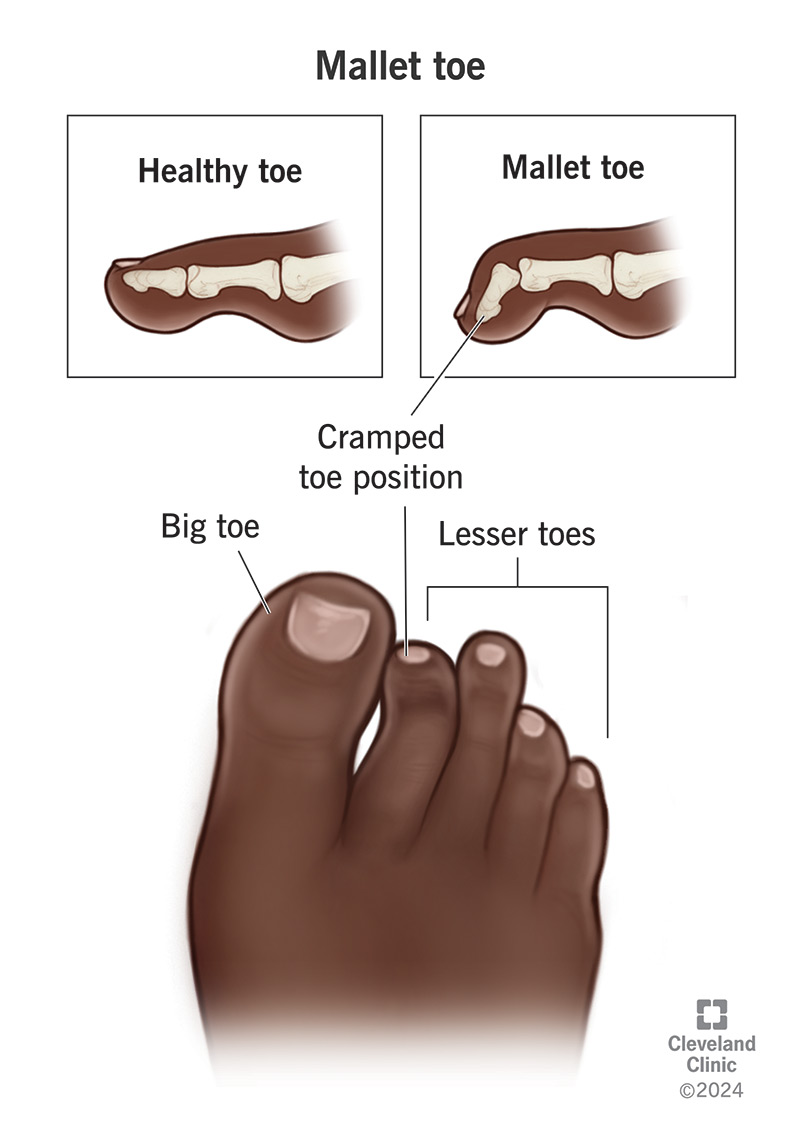Mallet toe is a deformity that affects the top joint of your toe at the tip, causing it to bend downward. Wearing shoes that squish your toes together can cause the longer toe (often the second toe) to buckle. If it stays like that too long, it can become permanent. Better footwear and practicing toe stretches can help reverse it.
Advertisement
Cleveland Clinic is a non-profit academic medical center. Advertising on our site helps support our mission. We do not endorse non-Cleveland Clinic products or services. Policy

A mallet toe has an abnormal bend or buckle in the top toe joint, nearest to the toenail. This causes the tip of the toe to curl or point down instead of lying flat. Mallet toe most often affects your second toe, next to your big toe, because this toe is often the longest. But it can also affect your third or fourth toe.
Advertisement
Cleveland Clinic is a non-profit academic medical center. Advertising on our site helps support our mission. We do not endorse non-Cleveland Clinic products or services. Policy
Your healthcare provider may describe your mallet toe as either flexible or rigid.
Flexible mallet toes are bent, but they can still bend back toward their normal shapes.
Rigid mallet toes are frozen in their bent positions. This type is trickier to treat.
Mallet toe is most recognizable by its appearance, with the downward-pointing tip of the toe forming the shape of a mallet. But it’s also uncomfortable to walk on. And by changing the way you walk, it can create secondary problems that also cause discomfort. Some of the symptoms it might cause include:
Mallet toe usually develops gradually, when forces — like the shoes you wear or the way you walk — cause a tendon in your toe to tighten and contract. The contracture is usually somewhat flexible in the early stages, but after a while, it becomes rigid and “fixed.” Contributing causes may include:
You may be more likely to develop mallet toe if you have a condition that affects the nerves in your feet and your ability to feel sensations in your toes. This might make it easier for you to injure your toe or walk with your toes in an awkward position without realizing it. Some of these conditions include:
Advertisement
A podiatrist can diagnose mallet toe with a thorough physical exam and X-rays. They’ll look at your shoes, how you walk and where your calluses are, then confirm with images of the joint. If they suspect you have an underlying condition, like arthritis or neuropathy, they might want to run additional tests.
In the earlier stages, when it’s still flexible, you might be able to treat and even reverse mallet toe with home remedies. Your provider might recommend changing your shoes, wearing orthotics or taping your toe. They might suggest exercises or physical therapy to stretch out your toe and improve its flexibility.
Even if your toe is rigid and inflexible, most healthcare providers will offer nonsurgical treatments first, focusing on your symptoms. Specialized footwear can help take pressure off your toe. Steroid injections can help relieve swelling and pain. If these don’t help enough, your provider might suggest surgery.
Surgeons use a variety of procedures to fix mallet toe. When possible, they use minimally invasive surgery techniques. For example, they might use ultrasound to guide a needle through your skin (percutaneous surgery). Or they might operate through a small hole with a scope (arthroscopy).
Mallet toe procedures include:
Most of the time, mallet toe can improve with conservative treatments, although these treatments may take time and persistence to work. Mallet toe becomes harder to treat if it goes untreated for too long and becomes rigid. If this happens, you might need surgery. But surgery usually succeeds in fixing it.
Since mallet toe usually happens gradually, taking care of your feet can help prevent it. If you notice symptoms like foot pain after walking or wearing certain shoes, consult a podiatrist. If you have a condition that makes your feet less sensitive, it’s important to check them regularly for signs of harm.
Advertisement
It’s easy to take foot pain for granted; but if it’s frequent, there’s a risk of real damage being done. Foot deformities like mallet toe can have a snowball effect on your ability to walk and your quality of life. If you notice physical changes, see your provider. Seek care sooner than later to prevent worse outcomes.
Advertisement
From sudden injuries to chronic conditions, Cleveland Clinic’s orthopaedic providers can guide you through testing, treatment and beyond.

Last reviewed on 08/05/2024.
Learn more about the Health Library and our editorial process.